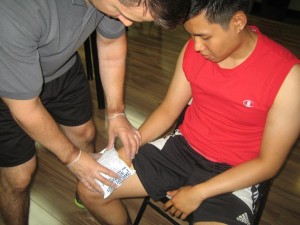San Francisco CPR has been one of the most popular training providers of CPR and first aid training in California. We offer a largest selection of programs for the cheapest training fees in the city – plus all courses have certificate as well. If you need either training or certification (or both), you won’t have any difficulty at San Francisco CPR.
We have also made enrollment very easy for our prospective students by making an application form available on our website. The form can be completed at any time of the day but all the requests are only processed and confirmed during business hours (expect replies to e-mails and calls during that time as well).
The Chain of Survival

As with other medical management techniques, the effectiveness of CPR can only be seen when there is a standard followed by rescuers who perform it. This standard comes in the form of a set of guidelines the AHA has dubbed “The Chain of Survival”. This is a series of five steps to follow, from recognition of cardiac arrest to post-CA care.
1. Recognition of cardiac arrest
This step is either very simple or very difficult. For untrained rescuers, it is easy. If a victim falls unconscious and is unresponsive to vigorous tapping/shaking and name-calling, assume cardiac arrest. Similarly, if the victim experienced severe chest pain prior to falling unconscious, he or she has mostly likely experienced a heart attack. For trained rescuers, checking the pulse, breathing, and consciousness should all be done in less than 20 seconds. Check for a pulse for no longer than 10 seconds, check for breathing, and attempt to awaken the victim before calling for help.
Once it has been established that the victim is experiencing cardiac arrest, call or have someone else call for help (the emergency hotline).
2. Chest compressions and ventilation
Compressions made to the chest are attempts to get blood circulating through the body during cardiac arrest. They are simple enough, as long as the rescuer remembers these tips:
- Rate – at least 100/minute
- Ratio – 30 compressions: 2 ventilation
- Compression depth – 1/3 of the anterior-posterior diameter
- Allow chest to recoil
- Push HARD and FAST
- Interlace fingers and place them in the center of the chest (on top of the sternum), in between the nipples.
Ventilations are used to keep the blood oxygenated during cardiac arrest, by giving rescue breaths to the victim. For untrained rescuers, the AHA doesn’t recommend giving rescue breaths.
- Tilt the head back and open the mouth by pushing the jaw down.
- Seal your mouth tightly over the victims’.
- Allow the chest to rise and fall between breaths.
- Use a barrier device if available.
The rest of the steps are typically performed by an EMT once the ambulance arrives or once the victim is brought to the hospital.
3. Defibrillation
4. Advanced Life Support
5. Post-cardiac arrest care
If you want to get certified in first aid and CPR training, sign up for any of our programs at San Francisco CPR. Enroll today!
